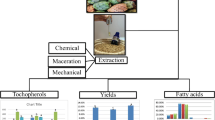Abstract
Grinding methods were evaluated aiming to determine yield and composition of essential oils (EOs) from Baccharis articulata (Lam) Pers., called as carqueja, a native plant from South Brazil. Cryogenic, knife (with and without cooling) and ball mills were used. The major constituents found in EOs were β-pinene, caryophyllene, spathulenol and caryophyllene oxide, but differences in 21 compounds were observed. All grinding processes reduced monoterpenes and oxygenated sesquiterpenes with concentration of hydrocarbon sesquiterpenes. The sesquiterpenes (hydrocarbons and oxygenated) were found from 63.55 to 86.02% while the monoterpene hydrocarbons’ concentration ranged from 13.98 to 36.45%. Plants milled with knife mill provided EOs with profile similar to those not grinded. Despite the lower working temperature, cryogenic milling resulted in smaller EO yield (0.40 ± 0.03%) in comparison to other grinding methods (yields from 0.50 ± 0.02 to 0.56 ± 0.03%) and different chromatographic profile. Microscopic analysis showed the smaller particle size provided by cryogenic grinding, which leads to glandular trichome rupture and consequently to loss of EOs. This study showed that grinding should be carefully evaluated to provide reproducible results in essential oil analysis.



Similar content being viewed by others
References
Azmir J, Zaidul ISM, Rahman MM, Sharif KM, Mohamed A, Sahena F, Omar AKM (2013) Techniques for extraction of bioactive compounds from plant materials: a review. J Food Eng 117(4):426–436. doi:10.1016/j.jfoodeng.2013.01.014
Binello A, Orio L, Pignata G, Nicola S, Chemat F, Cravotto G (2014) Effect of microwaves on the in situ hydrodistillation of four different Lamiaceae. C R Chim 17(3):181–186. doi:10.1016/j.crci.2013.11.007
Borella JC, Fontoura A (2002) Evaluation of the chromatographic profile and flavonoid content of samples of Baccharis trimera (Less.) DC., Asteraceae (carqueja) acquired in Ribeirão Preto, SP, Brazil. Rev Bras de Farmacogn 12(2):63–67. doi:10.1590/S0102-695X2002000200002
Bousbia N, Abert Vian M, Ferhat MA, Petitcolas E, Meklati BY, Chemat F (2009) Comparison of two isolation methods for essential oil from rosemary leaves: hydrodistillation and microwave hydrodiffusion and gravity. Food Chem 114(1):355–362. doi:10.1016/j.foodchem.2008.09.106
Budel JM, Duarte MR (2010) Macro and microscopic characters of the aerial vegetative organs of carqueja: Baccharis usterii Heering. Braz Arch Biol Technol. doi:10.1590/s1516-89132010000100016
Budel JM, Farago PV, Duarte MR (2013) Pharmacobotanical study of Baccharis cognata DC. (Asteraceae: Astereae). Lat Am J Pharm 32:550–556
Burt S (2004) Essential oils: their antibacterial properties and potential applications in foods—a review. Int J Food Microbiol 94(3):223–253. doi:10.1016/j.ijfoodmicro.2004.03.022
Deba F, Xuan TD, Yasuda M, Tawata S (2008) Chemical composition and antioxidant, antibacterial and antifungal activities of the essential oils from Bidens pilosa Linn. var. Radiata. Food Control 19(4):346–352. doi:10.1016/j.foodcont.2007.04.011
Filly A, Fernandez X, Minuti M, Visinoni F, Cravotto G, Chemat F (2014) Solvent-free microwave extraction of essential oil from aromatic herbs: from laboratory to pilot and industrial scale. Food Chem 150:193–198. doi:10.1016/j.foodchem.2013.10.139
Ghodki BM, Goswami TK (2016) Effect of grinding temperatures on particle and physicochemical characteristics of black pepper powder. Powder Technol 299:168–177. doi:10.1016/j.powtec.2016.05.042
Giuliano DA (2001) Clasificación infragenérica de las especies argentinas de Baccharis (asteraceae, astereae). Infrageneric classification of the Argentine species of Baccharis (Asteraceae, Astereae). Darwiniana 39(1/2):131–154
Haddad A, Sesso A, Attias M, Farina M, de Nazareth Meirelles M, Silveira M, Machado RD (1998) Técnicas básicas de microscopia eletrônica aplicadas às ciências biológicas. Sociedade Brasileira de Microscopia, p 80
Karpouhtsis I, Pardali E, Feggou E, Kokkini S, Scouras ZG, Mavragani-Tsipidou P (1998) Insecticidal and genotoxic activities of oregano essential oils. J Agric Food Chem 46(3):1111–1115. doi:10.1021/jf970822o
Markert B (1995) Sample preparation (cleaning, drying, homogenization) for trace element analysis in plant matrices. Sci Total Environ 176(1–3):45–61. doi:10.1016/0048-9697(95)04829-4
Murthy CT, Rani M, Rao PNS (1999) Optimal grinding characteristics of black pepper for essential oil yield. J Food Process Eng 22(2):161–173. doi:10.1111/j.1745-4530.1999.tb00478.x
Nerio LS, Olivero-Verbel J, Stashenko E (2010) Repellent activity of essential oils: a review. Bioresour Technol 101(1):372–378. doi:10.1016/j.biortech.2009.07.048
Oliveira AMA, Santos VLP, Franco CRC, Farago PV, Duarte MR, Budel JM (2011) Comparative morpho-anatomical study of Baccharis curitybensis Heering ex Malme and Baccharis spicata (Lam.) Baill. Latin. Am J Pharm 30:7
Pessoa LM, Morais SM, Bevilaqua CML, Luciano JHS (2002) Anthelmintic activity of essential oil of Ocimum gratissimum Linn. and eugenol against Haemonchus contortus. Vet Parasitol 109(1–2):59–63. doi:10.1016/S0304-4017(02)00253-4
Roeser KR (1972) Die Nadel der schwarzkiefer massenprodukt und kunstwerk der natur. Mikrokosmos 61:33–37
Rubiolo P, Sgorbini B, Liberto E, Cordero C, Bicchi C (2010) Essential oils and volatiles: sample preparation and analysis. A review. Flavour Fragr J 25(5):282–290. doi:10.1002/ffj.1984
Safaei-Ghomi J, Ebrahimabadi AH, Djafari-Bidgoli Z, Batooli H (2009) GC/MS analysis and in vitro antioxidant activity of essential oil and methanol extracts of Thymus caramanicus Jalas and its main constituent carvacrol. Food Chem 115(4):1524–1528. doi:10.1016/j.foodchem.2009.01.051
Sass JE (1951) Botanical microtechnique. Press, Ames, I.S.C
Singh KK, Goswami TK (1999) Design of a cryogenic grinding system for spices. J Food Eng 39(4):359–368. doi:10.1016/S0260-8774(98)00172-1
Souza J, Santos V, Franco C, Bortolozo E, Farago P, Matzenbacher N, Budel J (2013) Baccharis rufescens Spreng. var. tenuifolia (DC.) Baker: contribuição ao estudo farmacognóstico. Rev Bras de Plantas Medicinais 15(4):566–574. doi:10.1590/S1516-05722013000400013
Acknowledgements
The authors are grateful to CNPq, CAPES and FAPERGS for supporting this study and also to Carolina Côrte Real (in memoriam) and Matheus Rafael Raschen (in memoriam) for their assistance and dedication to this work.
Author information
Authors and Affiliations
Corresponding author
Electronic supplementary material
Below is the link to the electronic supplementary material.
11696_2016_52_MOESM1_ESM.tiff
Fig. S1. Chromatograms of volatile compounds from Baccharis articulata (Lam.) Pers. essential oil obtained by GC-FID usingdifferent grinding methods; a b-pinene, b limonene, c caryophyllene and d spathulenol. (TIFF 89 kb)
Rights and permissions
About this article
Cite this article
Tischer, B., Vendruscolo, R.G., Wagner, R. et al. Effect of grinding method on the analysis of essential oil from Baccharis articulata (Lam.) Pers.. Chem. Pap. 71, 753–761 (2017). https://doi.org/10.1007/s11696-016-0052-0
Received:
Accepted:
Published:
Issue Date:
DOI: https://doi.org/10.1007/s11696-016-0052-0




